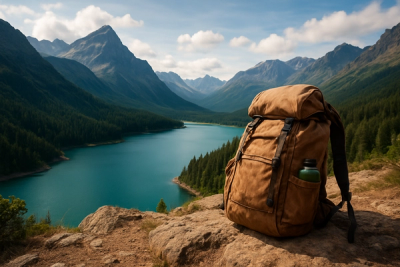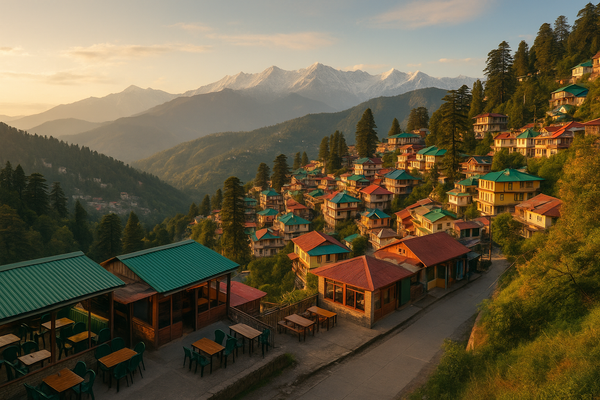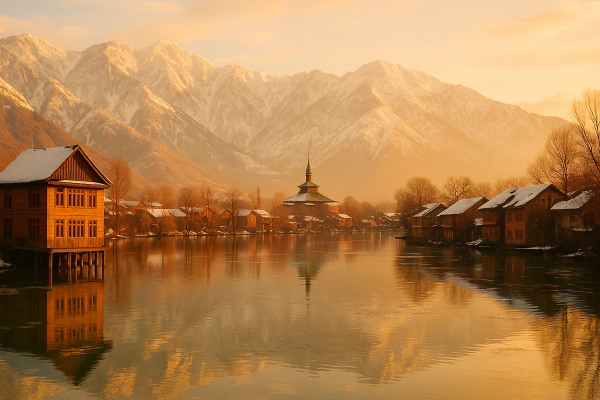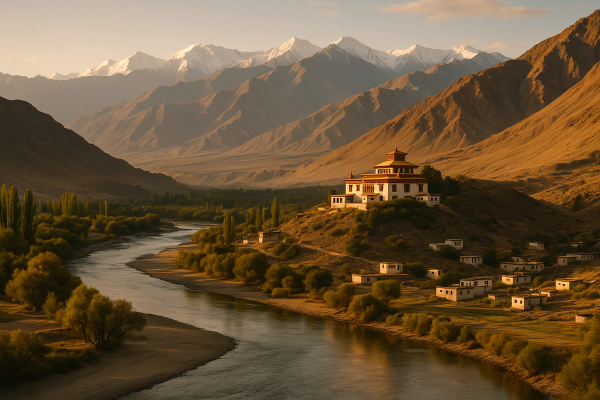Slow Travel in Hill Towns: Spend a Week, Not a Day in India & Asia (what it actually felt like in 2025)#
So I finally did it. I slowed down. Like really slowed down… A whole week in places people usually “day trip” or bang out in 48 hours with a checklist and an exhausted smile. In 2025 I set myself a silly rule: no new city unless I can give it 7 days. Hill towns in India & Asia were the perfect test—tea slopes and pine-smell mornings, bumpy buses, unreliable clouds, and kindness that kinda blindsides you when you stop rushing.¶
Why a week changes everything#
I used to do that hit-and-run travel—wake up at 5, chase waterfalls, zip back. But in Dharamkot (above McLeod Ganj, Himachal), Sapa in Vietnam, Ella in Sri Lanka, and Pai in northern Thailand, staying 7 nights felt like my brain went from “tourist” to “neighbor.” Barista remembered my name (and my oat-milk wierdness), I learned the rain schedule instead of fighting it, and I didn’t miss the good stuff because I wasn’t always leaving tomorrow.¶
- You meet actual people, not just vendors rushing the next group
- Food makes more sense when you eat your way through the week—breakfast momo, afternoon thukpa, late chai… repeat
- Weather isn’t a disaster. It’s just one day in a week. Monsoon tantrum? Go tomorrow
- Your budget breathes—weekly homestay rates in 2025 are often 10–20% cheaper if you ask (nicely) and pay in cash
India: the hill-town slow roll that surprised me#
Dharamkot & McLeod Ganj, Himachal Pradesh#
I spent seven nights in a tiny room up a stone path in Dharamkot, just above McLeod Ganj. My window faced cedar trees and prayer flags that got tangled when the wind got cheeky. Three days were pure wandering—stopping for Tibetan bread and honey, also buying yak-cheese that, uh, did not travel well. Day four I finally did Triund trek. In 2025 there’s still no permit fee for Triund itself if you’re just day hiking, but sherpa-guided overnights are more regulated and camps get checked for litter. On the way down I got stuck under a tin roof with two chai sellers and a curious goat and it was genuinely the best hour of my day.¶
Prices felt fair if you stay away from the Instagrammy spots. In spring 2025 I found homestays for ₹800–1,800 a night (simple room, hot bucket showers, decent Wi‑Fi if you sit near the router). Cafes are ₹120–250 for coffee, ₹200–350 for a bowl of thukpa. That all jumps in May–June (Indian school holidays) and again Sept–Oct. Sundays get busy with weekenders from Chandigarh. HRTC buses are bookable online now but, honest truth, I still just showed up and waved like a hopeful lemon.¶
- Heads up for 2025: monsoons have been mean the last summers—landslides in Himachal closed roads off-and-on. Keep at least one buffer day if you have a flight
- eSIMs actually work in Dharamkot now, but power cuts still happen. I kept a tiny power bank and didn’t hate myself for it
Sikkim: Gangtok, Dzongu homestays, slow tea#
I wasn’t planning to go deep in Sikkim but a driver nudged me toward Dzongu (Lepcha community area) and I stayed five nights in a family homestay where grandma brewed nettle tea and shared ghost stories. This is one of those places where permits still matter—foreign travelers in 2025 need a Restricted Area Permit (RAP), and North Sikkim routes (like Lachen/Lachung) are checked at police posts. After the 2023 flood, a bunch of roads were rebuilt and by 2025 most popular tracks were open, but closures happen after heavy rain. Gangtok itself felt busy, modern, and friendly, but if you want slow—go homestay. You’ll spend your time picking cardamom and watching fog climb the ridge like it's late for a meeting.¶
- ₹1,200–3,500 a night for homestays in 2025, meals included sometimes. Ask upfront; cash still preferred outside Gangtok
- Best months: March–May and Oct–Nov. July–Sept gets soaked—literally
Uttarakhand: Landour over Mussoorie (fight me, gently)#
Me and him went up to Landour for a week in 2025 and I genuinely forgot what hurry felt like. The loop walk under the deodar trees, ginger lemon tea at a cafe that smelled like cinnamon, and a morning where the clouds just sat in the lane and refused to move. Landour is quieter than Mussoorie; you’ll pay ₹1,500–3,500 for a good homestay or ₹4,000–8,000 for a boutique setup with, like, old wooden floors that creak in a nice way. Dehradun’s Jolly Grant airport has more flights this year, but if you can, take the train to Dehradun and a taxi up—it’s cheaper and you don’t get tossed around as much.¶
- Waste is an issue in 2025; carry back plastic, refill water. Locals will absolutely appreciate it
Asia rounds: Sapa, Ella, Pai, Bandipur—each needed seven days, not sprinting#
Sapa, Vietnam (Ta Van homestay > town hotel)#
Sapa’s town center is kinda busy, and the Fansipan cable car is still a thing (crowds, selfies, wind). But staying down in Ta Van or Lao Chai with a homestay family made it different. I spent six nights in Ta Van in early 2025 and split my days: rice terrace walks with a H’Mong guide, lazy noodles by the stream, nighttime stories about harvests and, weirdly, karaoke. Vietnam’s eVisa changed travel—since Aug 2023 it’s been 90 days multiple-entry, and in 2025 it’s still live. Super convenient if you’re bouncing Hanoi–Sapa–Ha Giang–back. Costs: $15–40 per night for homestays, breakfast included; guided treks $15–30 a day. If it rains, it pours. Bring real shoes (the red mud is vengeful).¶
- Sleeper buses directly Hanoi–Sapa are comfy now (ish), but I still prefer the night train to Lao Cai + local bus up—less motion sick
Ella, Sri Lanka (tea slopes and slow trains)#
Ella works best when you don’t stack it. I did two hikes (Little Adam’s Peak and the Lipton’s Seat near Haputale) and then just gave three afternoons to watching tea pickers move like metronomes. The Kandy–Ella train remains the vibe; in 2025 you can book seats online more reliably, though last‑minute choices are usually 2nd or 3rd class. Sri Lanka shifted to an eVisa system from the old ETA—tourists still get ~30 days, and fees vary by nationality, so check the official portal the week you book. Accommodation: $25–80 per night depending on view and breakfast. It’s busy, but if you stay seven nights you learn the trick: go to Nine Arch Bridge at odd hours (late afternoon when the sun softens) and skip mornings when influencers stage those jump shots (bless them but also… no).¶
Pai, Thailand (762 curves + extra days = sanity)#
I used to hate Pai honestly, felt too curated. But in 2025 after seven nights I found gardens and quiet corners behind the circus scene. Rent an EV scooter (lots of shops have them now; 200–350 THB/day) and do slow sunsets at Pai Canyon. Thailand’s visa landscape is shifting—late 2024 into 2025 they expanded visa‑exempt stays and pushed new flexible visas (that Destination Thailand Visa for longer creative/remote stays started rolling out). If you’re from the US/UK/EU/Aus you’ll likely get 30–60 days visa‑free depending on updates; please check the consulate right before you go because rules are, you know, rules. Homestays/guesthouses: 500–1,200 THB. Food is cheap if you eat local—khao soi for 60–120 THB. It’s still party-ish, but weekdays are mellow and sunrises are honestly magic.¶
Bandipur, Nepal (a balcony, old Newar houses, silence)#
Bandipur is my favorite seven-day nowhere. It’s a hilltop town between Pokhara and Kathmandu with traditional Newar architecture and those red flowers that drip over stone walls. In 2025 Nepal keeps visa on arrival for most travelers—$30 for 15 days, $50 for 30, $125 for 90—and the little immigration desks at KTM airport actually move quicker than before. If you’re trekking anywhere serious, Nepal’s guide rules and TIMS card requirements were tightened in 2023 and still apply in 2025 for many regions (not Bandipur though). Rooms are NPR 1,500–4,000 a night, tea terraces are free, and time is weird here—it just stretches.¶
2025 practical stuff you’ll wanna know before you go#
- India: eVisa is active in 2025 for many nationalities (30‑day, 1‑year, 5‑year options). Apply only on the official government portal—tons of scam sites copy the look. No COVID test needed now, but Yellow Fever proof may be asked if you’re coming from affected countries
- Vietnam: eVisa 90 days multiple entry continues in 2025. Trains to Lao Cai (for Sapa) often sell out on weekends—book early
- Sri Lanka: eVisa replaced the old ETA system; fees vary and they tweak them—check the official site right before travel
- Thailand: visa exemptions expanded and some stays are 60 days now for many. The new creative/remote work visa (DTV) started appearing late 2024 into 2025. If you’re staying longer, research that. Also, carry your International Driving Permit if you’re renting scooters—they did more checks this year
- Indonesia note (if you hop to hill villages in Bali like Munduk): Bali’s tourist tax (IDR 150,000) is in effect, 2024 onward, still applies in 2025
- Nepal: Visa on arrival is steady; for major trekking regions a registered guide/TIMS is expected in 2025. Travel insurance is heavily advised—medical evac ain’t cheap
Safety + weather in the hills (2025 realities)#
Monsoon patterns have gotten weird the last couple years, more sudden dumps. In Himachal and Uttarakhand I keep a buffer day in my itinerary now—landslides and road closures aren’t rare. Sikkim had that rough flood in 2023, and by 2025 most tourist routes are normal again, but officers will turn you back if conditions are bad. Altitude: Leh is gorgeous but I had a dumb day where I tried a hike on day two and paid for it—headache city. Don’t be me; acclimatize. In Vietnam’s north and Nepal, mud is the main villain. In Thailand, police checkpoints are more frequent in 2025; carry your passport copy and IDP. Everywhere: download offline maps, keep a local SIM/eSIM, and yeah, carry cash—ATMs work but hill towns love cash.¶
- Day 1: Arrive, nap, find your corner cafe. Don’t plan anything, just… exist
- Day 2: Easy walk. Chat with your host. Ask what people actually do here on a Tuesday
- Day 3: A bigger hike or a day trip—Triund, tea estate, terrace loops
- Day 4: Rest day. Laundry. Journal. Faceplant in a book
- Day 5: Food day—take a cooking class, eat with a family, find the weird snacks
- Day 6: Do nothing on purpose. Watch clouds. Let boredom sharpen your senses
- Day 7: One last early walk, buy something tiny and useful (spice, local soap), say real goodbyes
The hill towns don’t open up when you rush them. They open when you linger—you become familiar enough to notice the second flavor of the place.
Costs in 2025 (what I actually paid-ish)#
India (Himachal/Sikkim/Uttrakhand): budget ₹2,000–4,000 per day if you’re staying in homestays and eating local. Fancy places go higher quick. Vietnam (Sapa): $30–60/day if you’re sensible; night trains add extra. Sri Lanka (Ella): $40–80/day—food is cheap but viewpoints lure you into tuk‑tuk rides you don’t need. Thailand (Pai): ฿800–2,000/day depending on scooter and how craft beer you get. Nepal (Bandipur): NPR 3,000–6,000/day. In 2025 weekly discounts were real in all these places if I just asked and didn’t act like a spreadsheet dude. Cash got me a free breakfast twice. I’m not mad about it.¶
Where I stayed + little opinions#
Dharamkot: a family place up a lane with prayer wheels—basic room, honest smiles, and the auntie who insisted I eat more butter tea. Sapa/ Ta Van: wooden homestay with creaky floors and rice-field sunrise. Ella: a guesthouse above the track where the evening train slid by like a slow thought. Pai: bamboo bungalow near a rice field (mosquitos + gecko drama, but worth it). Bandipur: balcony with a valley view that made my morning coffee taste like a poem I can’t spell. None were perfect. All were perfect for staying seven days.¶
Food memories (aka the point of living slow)#
Tibetan momo in Dharamkot with chili sauce that wasn’t joking. Cardamom tea in Sikkim that smelled like a warm hug. Pho in Sapa with mountain herbs. Roti and pol sambol in Ella (coconut! forever). Khao soi in Pai where the noodles were somehow giggling. Sel roti in Nepal—sweet rings that made me wonder why donuts even bother. When you linger, you eat the second round at the same place—cook remembers you and adds that one extra spoon of something and wow.¶
Do I regret giving a week to each hill town?#
Nope. Not even a little. I lost the urge to tick boxes. I gained little routines—chai at 10, terrace walk at 4, writing till the geckos start gossiping. If 2025 is the year of slower, kinder travel (and honestly the trend charts say it is—more trains, fewer flights, longer stays, community run homestays getting love), then hill towns are where it makes sense. You don’t need a list. You need a balcony.¶
If you want more super chill travel stories and totally non-perfect tips, I toss my updates on AllBlogs.in now and then—swing by if you feel like it.¶














